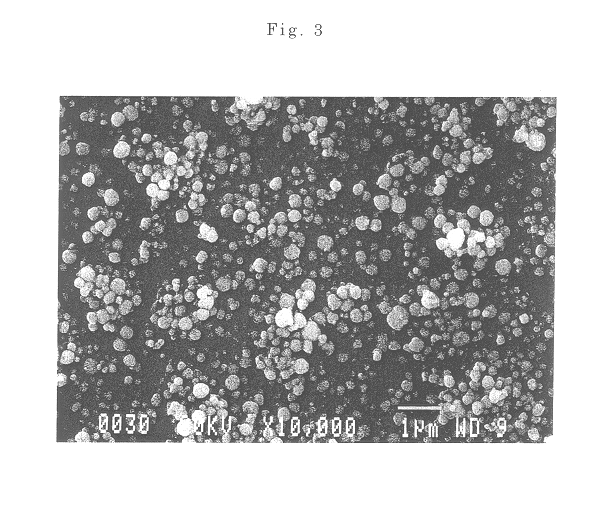Method for producing fine powder of metallic nickel comprised of fine spherical particles
a technology of metallic nickel and fine powder, which is applied in the direction of fixed capacitor details, fixed capacitor electrodes, etc., can solve the problems of non-uniform electrode layer, limited inner electrode of laminated ceramic capacitors, and inability to thin inner electrodes
- Summary
- Abstract
- Description
- Claims
- Application Information
AI Technical Summary
Problems solved by technology
Method used
Image
Examples
production example 1
Production of Fine Spherical Particles of Nickel Carbonate
141 g of commercially available basic nickel carbonate (NiCO.sub.3.multidot.Ni(OH).sub.2.4H.sub.2 O, the same hereunder) and 242 g of ammonium hydrogencarbonate (NH.sub.4 HCO.sub.3) were added to 15% aqueous ammonia and stirred to prepare an aqueous solution of basic nickel carbonate in ammonia-ammonium hydrogencarbonate (1.1 mol / L in terms of Ni) having a pH of 9.5.
30 g of a nonionic surfactant, polyoxyethylene sorbitan monooleate having an HLB value of 15 (RHEODOL TW-0120, available from Kao Corp.) was added to 200 g of the solution of nickel salt and stirred at a temperature of 50.degree. C. to dissolve the surfactant in the solution. Meanwhile, 50 g of a nonionic surfactant, sorbitan monooleate having an HLB value of 4.3 (RHEODOL SP-O10, available from Kao Corp.) were added at a temperature of 80.degree. C. to 800 g of a non-aqueous medium, squalan (Super Squalane, available from K.K. Squatech) having a boiling point of a...
production example 2
Production of Fine Spherical Particles of Nickel Oxide
The powder of the spherical particles of basic nickel carbonate was heated at a rate of 50.degree. C. / hour and fired at a temperature of 500.degree. C. for 3 hours in an air atmosphere to thermally decompose the basic nickel carbonate, providing fine spherical particles of nickel oxide having an average particle size of 0.45 .mu.m. It was confirmed by a scanning electron micrograph that the obtained particles were spherical and well dispersed. The nickel oxide powder used in the following examples and comparative examples was this powder produced in this Production Example 2.
Examples in Which Hydroxides or Oxides of Silicon or Aluminum Were Used as a Sintering Preventive Agent
example 1
11.6 g of power of spherical particles of basic nickel carbonate was dispersed in 20 mL of ion-exchanged water and 70 g of zirconia beads having a diameter of 1 mm were added. The resultant slurry was subjected to grinding with a planetary mill at a rate of 100 rpm for 10 minutes. The zirconia beads were separated from the slurry and washed thoroughly to recover the basic nickel carbonate therefrom and thus an aqueous slurry of basic nickel carbonate was obtained.
2.5 mL of aqueous solution of sodium metasilicate (Na.sub.2 SiO.sub.3, having a concentration of 100 g / L in terms of SiO.sub.2) was added to the slurry and stirred. While stirring and cooling the slurry with ice, 10% hydrochloric acid aqueous solution was slowly added dropwise to the slurry to neutralize the sodium metasilicate so that precipitates were formed.
Solid products including the precipitates were collected by filtering from the slurry, washed, and dried at 110.degree. C. overnight, to provide powder of basic nicke...
PUM
| Property | Measurement | Unit |
|---|---|---|
| particle size | aaaaa | aaaaa |
| temperature | aaaaa | aaaaa |
| temperature | aaaaa | aaaaa |
Abstract
Description
Claims
Application Information
 Login to View More
Login to View More - R&D
- Intellectual Property
- Life Sciences
- Materials
- Tech Scout
- Unparalleled Data Quality
- Higher Quality Content
- 60% Fewer Hallucinations
Browse by: Latest US Patents, China's latest patents, Technical Efficacy Thesaurus, Application Domain, Technology Topic, Popular Technical Reports.
© 2025 PatSnap. All rights reserved.Legal|Privacy policy|Modern Slavery Act Transparency Statement|Sitemap|About US| Contact US: help@patsnap.com



